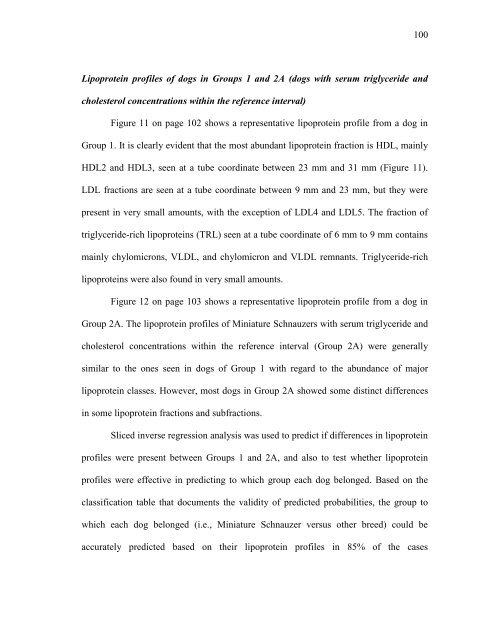INVESTIGATIONS INTO HYPERLIPIDEMIA AND ITS POSSIBLE ...
INVESTIGATIONS INTO HYPERLIPIDEMIA AND ITS POSSIBLE ...
INVESTIGATIONS INTO HYPERLIPIDEMIA AND ITS POSSIBLE ...
Create successful ePaper yourself
Turn your PDF publications into a flip-book with our unique Google optimized e-Paper software.
100<br />
Lipoprotein profiles of dogs in Groups 1 and 2A (dogs with serum triglyceride and<br />
cholesterol concentrations within the reference interval)<br />
Figure 11 on page 102 shows a representative lipoprotein profile from a dog in<br />
Group 1. It is clearly evident that the most abundant lipoprotein fraction is HDL, mainly<br />
HDL2 and HDL3, seen at a tube coordinate between 23 mm and 31 mm (Figure 11).<br />
LDL fractions are seen at a tube coordinate between 9 mm and 23 mm, but they were<br />
present in very small amounts, with the exception of LDL4 and LDL5. The fraction of<br />
triglyceride-rich lipoproteins (TRL) seen at a tube coordinate of 6 mm to 9 mm contains<br />
mainly chylomicrons, VLDL, and chylomicron and VLDL remnants. Triglyceride-rich<br />
lipoproteins were also found in very small amounts.<br />
Figure 12 on page 103 shows a representative lipoprotein profile from a dog in<br />
Group 2A. The lipoprotein profiles of Miniature Schnauzers with serum triglyceride and<br />
cholesterol concentrations within the reference interval (Group 2A) were generally<br />
similar to the ones seen in dogs of Group 1 with regard to the abundance of major<br />
lipoprotein classes. However, most dogs in Group 2A showed some distinct differences<br />
in some lipoprotein fractions and subfractions.<br />
Sliced inverse regression analysis was used to predict if differences in lipoprotein<br />
profiles were present between Groups 1 and 2A, and also to test whether lipoprotein<br />
profiles were effective in predicting to which group each dog belonged. Based on the<br />
classification table that documents the validity of predicted probabilities, the group to<br />
which each dog belonged (i.e., Miniature Schnauzer versus other breed) could be<br />
accurately predicted based on their lipoprotein profiles in 85% of the cases
















